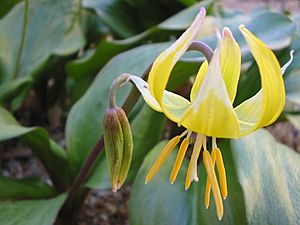Tuolumne fawn lily facts for kids
Quick facts for kids Tuolumne fawn lily |
|
|---|---|
 |
|
| 'Pagoda', Jardin des Plantes, Paris | |
| Conservation status | |
| Scientific classification | |
| Genus: |
Erythronium
|
| Species: |
tuolumnense
|
The Tuolumne fawn lily (Erythronium tuolumnense) is a beautiful flowering plant that belongs to the lily family. It is also sometimes called the Tuolumne dog's tooth violet. However, it is not a true lily or a violet. This special plant grows only in one small area: the Sierra Nevada mountains in Tuolumne County, California. This means it is endemic to that region. You can find it at elevations from about 600 meters up to 1000 meters.
This tough perennial wildflower grows from a bulb that is about 5 to 10 centimeters wide. Sometimes, it has smaller bulbs called bulblets growing with it. The bulb looks a bit like a dog's tooth, which is how it got its common name. The plant usually has two small leaves and a reddish stem that can grow up to 35 centimeters tall. Each stem can have one to five bright yellow flowers. The flowers have petals that curve backward. They also have a white center and white parts with yellow tips.
Contents
About the Tuolumne Fawn Lily
The Tuolumne fawn lily is a hardy plant. It grows well in moist, sunny woodlands where trees lose their leaves in the fall. This plant is not only found in the wild but also grown in gardens. A special type of this plant, called 'Pagoda', has even won an award for being a great garden plant. This award is called the Royal Horticultural Society's Award of Garden Merit.
Why is the Tuolumne Fawn Lily Important?
This plant is quite rare. It is found in only a few places. The biggest groups of these plants have more than ten thousand individuals. However, the Tuolumne fawn lily is considered "imperiled" by a group called NatureServe. This means it is at risk of disappearing.
Threats to the Tuolumne Fawn Lily
The Tuolumne fawn lily faces several dangers. These threats are mostly caused by human activities.
- Off-road vehicles: People using off-road vehicles in the plant's habitat can harm the largest groups of lilies.
- Logging: Cutting down trees in the area can destroy the places where these lilies grow.
- Other activities: Mining, dumping garbage, and camping can also damage their natural home.
- Fire suppression: Stopping natural wildfires can sometimes change the environment in ways that are not good for the lily.
Protecting these special areas helps the Tuolumne fawn lily survive for future generations.
See also
 In Spanish: Erythronium tuolumnense para niños
In Spanish: Erythronium tuolumnense para niños


